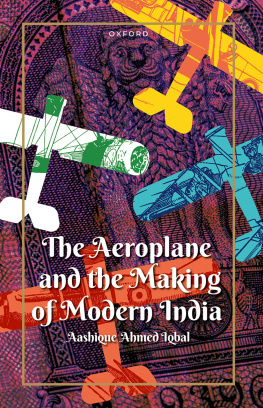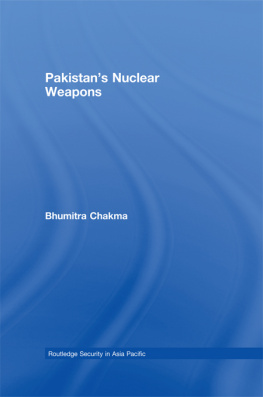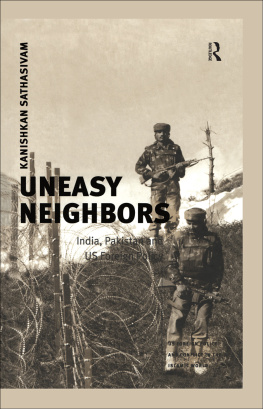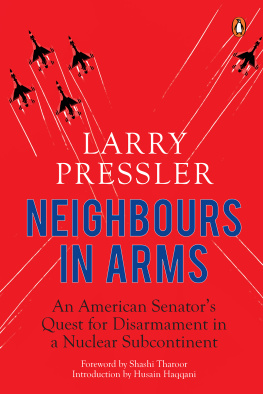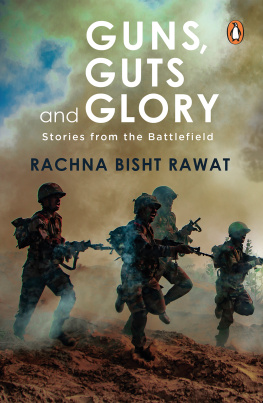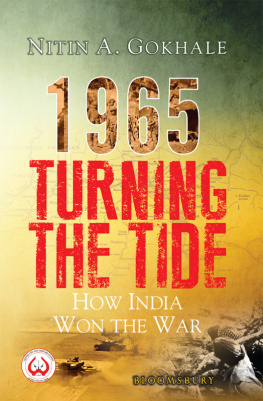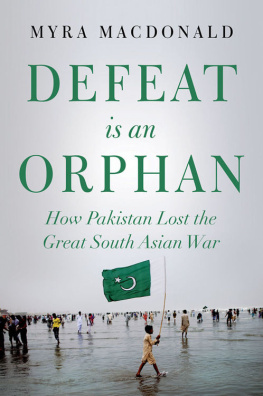Copyright 2017, Mandeep Singh
First Published in 2017
ISBN : 978-93- 86457-12-7 (Hardback)
ISBN : 978-93- 86457-13-4 (ebook)
Designed and Setting by
Vij Books India Pvt Ltd
2/19, Ansari Road, Darya Ganj,
New Delhi - 110002 (India)
www.vijbooks.com
All rights reserved.
No part of this book may be reproduced, stored in a retrieval system, transmitted
or utilized in any form or by any means, electronic, mechanical, photocopying,
recording or otherwise, without the prior permission of the copyright owner.
Application for such permission should be addressed to the author.
Preface
The commemoration of the Golden Jubilee of the 1965 War against Pakistan drew a wide range of comments, for the most part appreciative, from across the country. There were some voices questioning the whole exercise in celebrating the victory but the overall mood seemed celebratory. In this, what could have been an excellent opportunity to learn some valuable lessons appears to have been lost. Also, the re-writing of history to paint a stalemate as a grand victory has its own pitfalls. Hopefully that will not be the case. The mood was not restricted to the Indian side of the fence. Even Pakistan which celebrates September 6 as the Defence of Pakistan Day suffers from the same malady. As the Noted Pakistani historian, K. K. Aziz, in his Murder of History: A Critique of History Textbooks Used in Pakistan (1998) observed many moons earlier:
In Pakistani schools and colleges what is being taught as history is really national mythology, and the subjects of Social Studies and Pakistan Studies are nothing but vehicles of political indoctrination. Our children dont learn history. They are ordered to read a carefully selected collection of falsehoods, fairy tales and plain lies.
The myth and mystery around the 1965 War is no exception. Unfortunately, there is a tendency to create more myths which only add to obfuscating the truth. One example is the popular belief that IAF defeated the PAF during the 22 day war in September 1965 though Shekhar Gupta is nearer to the truth when he wrote in an article for NDTV (The War Pakistan Lost and India Didnt Win can be accessed at http://www.ndtv.com/opinion/the-war-pakistan-lost-and-india-didnt-win-1217407) that Pakistan lost the War, but we(India) did not win it.
In this, the narrative of Anti Aircraft Artillery (AAA) is quite interesting, intertwined as it is with the narratives of both the Air Forces and the Armies. And neglected and overlooked by both the Air Force and the Army, for they both feel AAA does not belong to them. For the Air Force, AAA is most of the times just some people shooting wildly in the dark and more of a nuisance than a necessity while the Army believes Air Defence is something to with Air Force and not them. As a result, the AAAs narrative is missed out by both. But numbers tell quite a tale.
22 days, 21 Indian AD Regiments, 26 PAF Kills, and Four Vir Chakras. IAF on its part got 17 kills in air to air combat and all the IAF pilots who shot down PAF aircraft were awarded gallantry awards.
The first IAF aircraft lost in combat on September 1 was to AAA. As was the last. Of the 25 IAF aircraft losses in the air( less accidents), 11 were due to Pak AAA while the balance 14 were lost in air to air combat to PAF.
While there are enough narratives of the gallant dog fights, there are hardly any narratives of IAF action against targets defended by Pakistan AAA. The AAA is not discussed though its impact was felt in all missions not only in the planning and execution of the missions but the outcome or success of any missions was deeply influenced by AAA. Similarly, the presence, and more importantly its absence was felt whenever air came on to the battlefield. In this, Indian Army felt the absence of integral AAA more, PAF being more active in providing close air support to Pakistan Army.
Viewed chronologically, the first loss of an aircraft during the Indo-Pak War was a PAF F-86 which crashed in April 1965 during the Rann of Kutch standoff after being hit by Indian AAA well before the formal declaration of War in September 1965. The last aircraft lost to Air Defence was after the declaration of cease fire when a PAF B-57 was claimed by SA-2 Surface to Air Missile of the IAF. Even with all this, it is rather surprising that there is no account of the AAA during the 1965 conflict.
With such interesting nuggets, there were enough stories to be put together and while trying to put together the narrative of AAA, it was rather a shock and surprise to read the following in The India-Pakistan Air War of 1965 by Jagan and Chopra-
The available evidence suggests that the Sabre claimed by Madlai Muthu was in fact shot down by Cooke
The reason for the surprise was simple enough. Having been commissioned in 28 Air Defence Regiment in December 1982, I had grown up listening to the account of Naik Madlai Muthus bravery and how he shot down a PAF F-86 Sabre at Kalaikunda airfield on September 7, 1965. Madlai Muthu was part of the Regimental folklore and his saga of gallantry a part of the induction training for all new recruits. Naik Muthu of B Troop was THE hero. Reading about him being referred to in this manner in Jagan and Chopras book seemed like blasphemy. The account as per the regimental history was crystal clear about a Sabre being shot down by Nail Muthu but then Jagan and Chopra were also very emphatic in their stand that there was no corroborative evidence to show that Muthu shot down a F-86. It was at best an exaggerated claim in line with the tendency of AAA to exaggeratedly claim kills even when the aircraft as shot down by IAF. This in fact started my quest to try and find out the details of the AAAs participation in the 1965 Indo-Pak War. On the way, there were enough incidents and stories to keep my interest going.
While reading about the Indo-Pak Air War of 1965, it was almost by accident that I came across an article about Flying Officer Waleed Ehsanul Karim of the Pakistan Air Force who died in an aircrash on April 19, 1965. Karim was born in July 1944 at Coxs Bazar, (now in Bangladesh) and went on to join the 36th GD(P) Course at Pakistan Air Force Academy in August 1961. He was commissioned in the PAF on 22 June 1963 and joined the No 17 Squadron PAF (The Tigers). One of the better pilots of PAF, he was reportedly well known in the Air Force for his daring stunts on the F-86 Sabre. Ehsanul Karim took part in the Republic Day fly past at Rawalpindi on 23 March 1964. During the standoff in the Rann of Kutch, Ensanul Karims Squadron was moved from Mauripur to Badin. As per the account available, his Squadron participated in the operations and assisted Pak Infantry in their assault by dropping smoke bombs- to screen their advance from observation by Indian Army. While carrying out one such mission, his aircraft was reportedly hit by AA fire on the morning of April 19, 1965. Ensanul Karim managed to nurse his Sabre back to Badin where the aircraft was repaired. The same evening, he was on a reconnaissance sortie over Gujarat when his Sabres engine developed a snag apparently the damage by AAA had not been repaired properly- and the Sabre plunged into the Arabian sea about 1015 miles off the south coast of Karachi.


